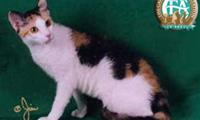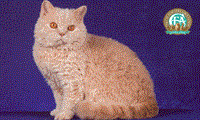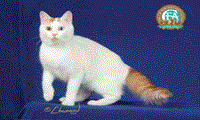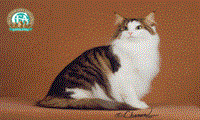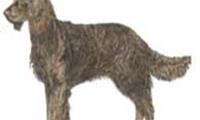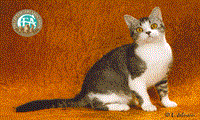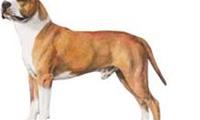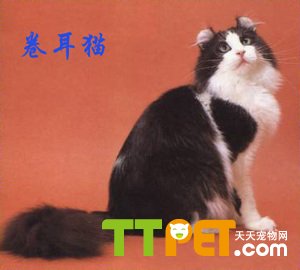
美國CFA對美國卷耳貓的品種標準介紹的中文翻譯版本以及英文原版。
該品種原產美國, 有人叫卷耳貓,
第一隻的美國卷耳貓於1981年在美國的加州被發現, 直至1986年被美國CFA正式承認為認可品種之一而在1993年被列入Championship的比賽組別。 美國卷耳貓有長毛及短毛品種, 亦有多種顏色和圖案, 但在美國CFA的比賽中, 無論是長毛或短毛均歸納于長毛組。
卷耳貓身材中等體重輕巧, 兩耳高聳並相對反曲, 模樣清秀俊俏, 惹人喜愛。 卷耳貓熱愛和平及聰明伶俐, 好粘主人, 溫純可愛、警戒和活潑, 喜歡坐在人的大腿部讓人撫摩, 與人相處極好。
美國卷耳貓的耳朵絕對不是人工所造成, 而是經遺傳基因突變而形成的。
美國卷耳貓有長毛及短毛品種, 亦有多種顏色和圖案, 但在美國CFA的比賽中, 無論是長毛或短毛均歸納于長毛組。
卷耳貓熱愛和平及聰明伶俐。 剛出生的卷耳貓, 其耳朵都是直的, 但在出生後的二至十天之內, 耳朵便會漸漸向後反起, 直至四個月大的時候便會定形。
性 格
卷耳貓溫柔可愛, 喜歡坐在人的大腿部讓人撫摩, 與人相處極好,喜歡撒嬌, 目前數量較少, 很難找到其身影。
特 征
身體稍長, 腿和尾較長, 雙耳反卷, 屬中型貓。 卷耳貓身材中等體重輕巧, 兩耳高聳並相對反曲, 模樣清秀俊俏,
理想的美國卷耳貓是身型均稱, 肌肉恰到好處, 雌性一般的體重由五至八磅不等, 雄性則是七至十磅。 頭部稍呈橢圓形, 適當長度而挺直的鼻子, 沒有鼻節, 由眼睛的底部上延至額頭。
結實的下巴, 與鼻及上唇成一直線。 耳朵反起的角度最少有九十度, 但又不能超過一百八十度。 適當大的耳朵, 底部寬闊, 流暢地向後反起。 眼睛呈胡桃形, 略大而稍帶傾斜, 橢圓形的頂部及圓形的底部。
顏色方面, 有純色、銀影、煙色、斑紋、雙色及重點色等等…
美國CFA對美國卷耳貓的評分標準如下:
頭部 (20分)
形狀及大小 8分 輪廓 6分 嘴 4分 下巴 2分
耳朵 (30分)
反耳程度 10分 耳形及大小 10分 位置 8分 陳設 2分
眼睛 (10分) 形狀及大小 6分 位置 3分
顏色 1分身體 (25分)
軀幹及頸 9分 大小及骨骼 6分 腿及腳 5分 尾巴長度 5分
毛髮及顏色 (15分)
絲質感 6分 極小底毛 4分 身體毛髮長度 2分
CFA官方網站關於美國卷耳貓的品種介紹的英文原版:
Breed Profile: American Curl
Boasting head adornments that could have easily been fashioned by a legendary hat designer, along with their opulently plumed tails reminiscent of a luxurious ostrich-feather boa, the American Curl has audiences in awe worldwide. Distinguished by truly unique ears that curl back in a graceful arc offering an alert, perky, happily-surprised expression, people break out into a big smile when viewing their first Curl. Designed exclusively by Mother Nature, the ears can be likened to those of a Lynx with long tufts fanning outward accentuating the swept-back look, while complementing the Curl's overall sophistication, stylish elegance, and dynamic presence.
Wake-up call! The alarm rings and emerging out from under the covers eager to start the day is your Curl buddy. Eyelid pats, nose kisses, and hairlicking prompt a gentle awakening. Then your eyes focus on that exuberant little Curl face, and another day begins. The Curl personality is truly unique. If not sleeping up high somewhere in a large salad bowl, figuring out with great determination just how to get into the shower with you, or assuming their spot right in front of a favorite TV show, they are patting at your glasses while you try to read the paper. Needless to say, Curls are very people-oriented, faithful, affectionate soulmates adjusting remarkably fast to other pets, children, and new situations. People say they are very dog-like in their attentiveness to their owners, following them around so not to miss anything. When introduced into a new home, Curl's seem to have an inherent respect for the current pet occupants, giving them plenty of room to adjust to the new kid on the block. Not overly talkative, the Curl's curiosity and intelligence is expressed through little trill-like cooing sounds. Because they retain their kitten-like personality well throughout adulthood, they are referred to as the Peter Pan of felines.
When Curls are born, their ears are straight. In 3 to 5 days they start to curl back staying in a tight rosebud position, unfurling gradually until permanently et' at around 16 weeks. This is the time breeders determine the kitten's ear quality as either pet or show in addition to the kitten's overall conformation. The degree of ear curl can vary greatly, ranging from almost straight (pet quality) to a show quality ear with an arc of 90-180 degrees resembling a graceful shell-like curvature. Although the distinctive feature of the American Curl is their uniquely curled ears, the medium-sized rectangular body, silky flat-lying coat, and expressive walnut-shaped eyes are equally indicative of the breed. They are available in both long and shorthair color and pattern varieties, and since there is minimal undercoat, the Curl sheds little and requires hardly any grooming.
On a typical hot June day in 1981, a stray longhaired black female cat with funny ears mooched a meal from Joe and Grace Ruga in Lakewood, California, and moved in. "Shulamith" is the original American Curl to which all bona fide pedigrees trace their origin. No one ever suspected that from that simple encounter, and the birth of some kittens 6 months later, would grow a worldwide debate about the genetics behind those unusual curled ears. When selective breeding began in 1983, fanciers bred the American Curl with an eye toward developing a show breed. In analyzing data on 81 litters (383 kittens), renowned feline geneticist, Roy Robinson of London, England, confirmed that the ear-curling gene is autosomal dominant, which means that any cat with even one copy of the gene will show the trait. In the December 1989 Journal of Heredity, Robinson reported finding no defects in any of the crosses he analyzed. This information provided the pathway for a new and healthy breednd one with an outstanding temperament.
Indeed, the discovery of a novel cat is an event of great importance to feline fans and fanatics, and especially true when it is inherently born to radiate well-being and good things to all fortunate enough to hold one. As the founder of this amazingly spiritual breed says, "They are not just ecorator' cats. You might say that they are esigner' cats, perhaps even signed masterpieces of a humor-loving Creator."
Pricing on American Curls usually depends on type, applicable markings and bloodlines distinguished by Grand Champion (GC), National, National Breed and/or Regional winning parentage (NW, BW, RW) or of Distinguished Merit parentage (DM). The DM title is achieved by the dam (mother) having produced five CFA grand champion/premier (alter) or DM offspring, or sire (father) having produced fifteen CFA grand champion/premier offspring. Usually breeders make kittens available between twelve and sixteen weeks of age. After 12 weeks, kittens have had their basic inoculations, and developed the physical and social stability needed for a new environment, showing, or being transported by air. Keeping such a rare treasure indoors, neutering or spaying, and providing acceptable surfaces (e.g. scratching posts) for the natural behavior of scratching (CFA disapproves of declawing or tendonectomy surgery) are essential elements for maintaining a healthy, long and joyful life
There are CFA clubs devoted to the promotion, protection and preservation of the American Curl breed. For more information, please send inquiries to CFA, PO Box 1005, Manasquan NJ 08736-0805.

